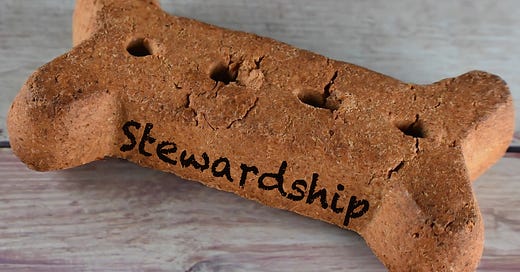The fiduciary's divided loyalties
To monetize or to supervise a future obligation? Only one doesn't bite
Intent is baked into things we legally own. Like a business predator that removes a threat to market share. Own it with the intention to eliminate it. Or, as a connoisseur building a collection. Own it to admire it. You might own something to consume it like stew or the last inklings of utility in the ancient blue Datsun four-door.
The relational verb “to own” is gallingly vague about what it means for the acquired when it’s put together with the acquirer, and vice versa.
Arguably, the default understanding of “to own” in modern society is tragically simplified: To know how much something is worth in resale.
That, to our collective misfortune, reduces everything to a stone-cold number — return on investment, yield, margin, gross domestic product — at the expense of any qualitative value that doesn’t fit neatly into a trend line.
As this post asks you to consider, ownership is far more complicated than price.
As only one example, but the most epic, public pension plans reduce the future to a dollar metric that erases any sense of qualitative impacts to that future. This, we argue, is nonfiduciary. Our Massachusetts Senate Bill 1644 makes clear that public pensions “own” a qualitative duty to their beneficiaries retiring tomorrow or in 2063 that is crafted by how fiduciaries wield their billions and trillions today. Technically, yes, we don’t know what the future holds, but we have a pretty good guess. It’s not a number. It’s a quality of life. We do not, at planet-scale, act accordingly.
For staters, it's a mistake to act as though ownership is simple, or that it is just one way, the definition of freedom or even precise. The bigger the thing owned, the more profound that error is — especially if you don’t understand what it is that you actually own.
Stuff we own often has covenants — expectations or even regulatory oversight that says you can do this, but not that. Some possessions hold rank over other possessions. Other times, you can’t hold the item in your hand but only in your mind.
You might own your life, but how many times has it owned you back?
Right. Trippy. Let’s talk about puppies instead
When I adopt a puppy from the shelter, I know what I am signing up for, including chewed flip flops and other dog-related costs required of someone called “owner.”
If, instead, I own a puppy mill, then my focus is not on the dogs’ wellbeing but on how much the dog units will fetch from buyers not interested in how their purchases are sourced.
In one case, I own something to sell it. To distinguish it among all the kinds of ownership positions, we call this “Speculative Equity” — extractive ownership for growth, capital gains, investment income, resale value and other stone-cold numbers. My loyalty is to maximizing the selling price I can get in the market of buyers regardless of the item. This is the profit motive that riles activists in the climate space and this intention is where fiduciaries begin to fail at their duties.
In the other case, I own something to maintain it. We call this “Stewardship Equity” — characterized by longevity, accountability and responsibility. My loyalty is to the item that I own through a purchase or inheritance or by legal decree. I do what is “sufficient” for the item regardless of the budget required to maintain it or how much it might be worth to a buyer. This is what we want fiduciaries to do.
Neither ownership “intention” is bad on its own unless your ownership is regulated toward stewardship but you’re acting speculatively. This is the basis for our paradoxical declaration that fiduciary common practice among global public pension “owners” is non fiduciary.
What do pensions own? It’s not puppies
If I “own” the idea that fiduciaries are untapped climate heroes, I have a responsibility to prove it, otherwise the value of the idea fades despite any potential it holds. I’m stewarding it… like, right now.
PRIM is just one public pension fiduciary on the planet. It doesn’t describe itself this way, which is the nature of the problem we have identified, but it “owns” a pension promise to 300,000 Massachusetts public sector workers redeemable as security in the future. As such, PRIM must adhere to certain limitations — similar to zoning bylaws for property developers — to ensure protections for the thing owned and who might be impacted. PRIM can be sued if it does not adhere to those duties.
To what effect? I’ll explore that in a future post. However, as with all billion- and trillion-dollar public pensions, how, why and for whom PRIM operates as an owner of a future promise has consequences for everyone.
When you, a public sector employee, hand over your 9% paycheck deduction to PRIM, you are ceding ownership of that money to a fiduciary who has something called “plenary authority” to decide how the money carries on from there — led by clear covenants. You, as a ward protected by those covenants, are buying future security. This is why we say that pensions are futures bought on layaway.
You can’t tell a pension fiduciary what to do, but you can demand they defend why they did it.
Asserting alpha dog status
As if understanding the owner's intention weren’t enough, there is a hierarchy for things owned. Again, this is where fiduciaries of vast public pensions have gotten lost: Among all the things they own, what is the single-greatest priority?
Fiduciaries have a Duty of Loyalty which dictates that the beneficiaries’ dignified futures come first. For clarity, “dignified” does not reduce to a number but to a quality of living. If a fiduciary is loyal only to monetizing the tools for the promise rather than the supervision of the promise, the fiduciary is in breach. This misplaced, divided loyalty is what defines non-fiduciary fiduciary practice.
To illustrate:
The new dog needs fancy food to thrive so I fill my pantry with, essentially, a tool to steward her. I could cheap out and get the non-fancy food, but that undermines her wellbeing and, by not putting her interests first, I invite scrutiny about whether I’m a responsible owner.
Whichever way I fulfill the Duty to Feed the Dog, the food does not need a dog. That’s silly, right? Ergo, among my possessions, the dog (which I own) is superior to her food (which I also own). Fussing about the stewardship tool means I’ve taken my eye off what I am stewarding. I am being disloyal.
Like the dog needs food, a pension promise needs money to thrive. What kind of money that is — and whether it puts a fiduciary’s array of pension promisees first — has a direct impact on the pension promise’s health and speaks to the fiduciary’s adherence to the duties required.
Again, silly, but the pension’s money does not need a pension promise — unless you've totally forgotten about what the fiduciary actually owns. Ergo, among the possessions of a public pension fiduciary, the pension obligation (that the fiduciary owns) is superior to the money that sustains the obligation.
To focus on the money rather than what the money is supposed to feed is a breach in fiduciary duty — and ubiquitous global common practice. It’s far worse than silly. So, yes, in dog terms, the whole world of fiduciaries is feeding crap to the future.
Bad dog!
The financial crisis of the Thames Water Utility is a particularly vivid case study in how public pensions show up as owners in society.
Privatized in 1989 in a £7.6-billion deal at the time, Thames Water is today a cautionary tale about the perils of price-extractive economies funded in large part by pension investment. Through a series of transactions over the years with other utilities, investment banks, pension funds and sovereign funds, the once publicly-owned and debt-free Thames Water has ballooned its inflation-sensitive debt. All this, while paying its shareholders dividends worth billions, hiring pricey executives, raising rates for its 15 million users and inducing million-dollar environmental fines. It’s dire enough that the government may have to step in to nationalize the company.
The Ontario Municipal Employees Retirement System (OMERS) owns 32%, starting in 2017, and the British Columbia Investment Management Corporation (BCI), the business arm of another Canadian pension, owns 8% dating back to 2008. Other public pensions own another 22%. As far as I can find, they have done nothing to help directly. If 62% of the ownership of Thames Water wanted the issue resolved because it’s the fiduciary thing to do, the crisis would be down the reparative road toward a time when cashflow is positive.
Instead, they look for an exit strategy, which is a cynical speculative equity move. OMERS’ accountants recently wrote down the book value of its investment by 30% because its dwindling fair market value, the price someone will pay for a utility with £14-billion in debt, has “impaired” the asset.
“Analysts… report that OMERS and BCI are expected to weather the storm with minimal financial damage given their size, diversification and long-term performance — even if Thames Water were to collapse — but there is reputational risk for the Canadian pensions, which could affect future investment opportunities,” wrote the Financial Post in early July.
No matter the extent of the pensions’ culpability in the London water crisis — or their onus for resolving it — it redounds to a bad guess, a black-eye talking point in future investment meetings, and because of the colossal scale of the pensions, a smudge on their income statements.
If pensions can’t demonstrate their duties of “Loyalty”, “Care” and “Impartiality” in the enterprises they choose as representative of their fiduciary duty, then what does it say about how they regard their ownership of the obligation to promisees?
Best in show
If there is one type of owner in the world that can define how we all live in the future, it’s a fiduciary of a public pension plan. Globally, fiduciaries have a $30 trillion stewardship tool tragically maladapted by speculators — cleaving loyalties, which is a no-no, and making pensions complicit in the climate crisis impasse.
This breach reflects neither the scale of pension plans nor their immortality — to be there in the future to deliver dignified retirements. As with any perpetual motion machine, the public pension must account for waste heat from friction and other immortality and operational expenses. Vampires need blood. No one gets a free ride to eternity.
So, “pensions need to make money” is not a conflicting idea in our proposal for Stewardship Equity. PRIM must replenish its $100-billion fund, but that is for the sake of the pension promise, rather than a “mandate is to construct and manage a portfolio of investments that delivers strong risk-adjusted returns” through risky speculation.
The only stone-cold number that truly matters is the average actuarial return — a percentage annual financial target the weighs all variables to ensure the plan can deliver a future worth retiring into whenever it is due. Presently, that number is 6.9% per year. It’s not whether fiduciaries need to make money, but how they make money.
If your loyalty is to the dollar sign, you have no concern how the 6.9% is earned or whether it also buys climate chaos. If your loyalty is to the item, you worry about how it fares in the pursuit of the 6.9%.
I suppose it could be more work in vetting an investment for its ability to meet actuarial minimums and to curate a viable future for promisees, but that is the literally the job of a public pension fiduciary owner.
Ask them, “How much is the future in the window?”
The proper fiduciary answer is, “The future is priceless. It’s not for sale.”









